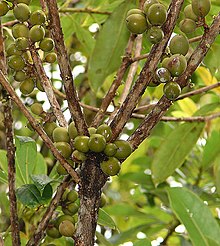| Petroleum nut | |
|---|---|

| |
| Scientific classification | |
| Kingdom: | Plantae |
| Clade: | Tracheophytes |
| Clade: | Angiosperms |
| Clade: | Eudicots |
| Clade: | Asterids |
| Order: | Apiales |
| Family: | Pittosporaceae |
| Genus: | Pittosporum |
| Species: | P. resiniferum
|
| Binomial name | |
| Pittosporum resiniferum | |
Pittosporum resiniferum, the resin cheesewood[2] or petroleum nut, is a tree that grows in the Philippines and Malaysia, particularly in the wilderness surrounding the Mayon Volcano and in the Cordillera of the Philippines and Mount Kinabalu of Sabah, Malaysia.[1] The petroleum nut derives its name from the resemblance of the fruit's odor to petroleum-based fuels. The fruits of the tree burn brightly when ignited, and can be used for illumination as torches or candles.[3] Its fruit is also highly suitable for use in producing biofuel. This use has been encouraged by the Philippines Department of Agrarian Reform and the Philippine Coconut Authority.[4]
In the Philippine Cordilleras petroleum nut is locally known as apisang, abkel, abkol and da-il, is found among other trees like oak and other mossy forest species. It can also grow well with pine trees.[5]
The oil obtained from the fruit contains a dihydroterpene(C10H18)[6] and also considerable quantities of normal heptane, which had only once before been found in nature, occurring in the Grey Pine (Pinus sabiniana) of California. The oil can also be distilled into a very pure form of n-Heptane.[7]
References[edit]
- ^ a b Sugau, John B. (1995). "Pittosporum resiniferum Hemsl.". In Soepadmo, E.; Wong, K. M. (eds.). Tree Flora of Sabah and Sarawak. (free online from the publisher, lesser resolution scan PDF versions). Vol. 1. Forest Research Institute Malaysia. p. 303. ISBN 983-9592-34-3. Archived from the original (PDF) on September 27, 2013. Retrieved June 27, 2012.
- ^ USDA, NRCS (n.d.). "Pittosporum resiniferum". The PLANTS Database (plants.usda.gov). Greensboro, North Carolina: National Plant Data Team. Retrieved 6 October 2015.
- ^ Duke Energy Handbook www.hort.purdue.edu. Accessed May 17, 2007
- ^ Bengwayan, Michael (November 15, 2010). "Petroleum Nut: Sustainable, Wonder Biofuel". Pine Tree Cordillera Ecological Center. Ideas Connection. Retrieved November 17, 2010.
- ^ Malanes, Maurice (December 27, 2011). "Social network paves way for interest in fuel-producing tree". Philippine Daily Inquirer. Retrieved January 2, 2012.
- ^ "Pittosporum resiniferum".
- ^ "Pittosporum resiniferum Petroleum nut PFAF Plant Database".
External links[edit]
- Handbook of Energy Crops
- Asian Journal: 2 wild plants eyed for bio-diesel
- Social network paves way for interest in fuel-producing tree